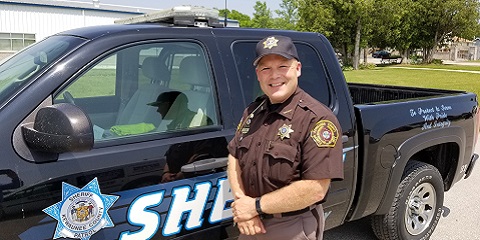Post-traumatic stress disorder is not just associated with the veterans in your life anymore. Approximately 11 to 20 percent of Operation Iraqi Freedom and Enduring Freedom veterans suffer PTSD in a given year, according to the U.S. Army, compared to 18 percent of Gulf war veterans and 30 percent of Vietnam veterans. The prevalence of school shootings, significant accidents, and other similar events is part of why more people are starting to suffer from PTSD. According to the National PTSD Organization, those suffering from the disorder are more likely to abuse alcohol and drugs than the general population. Even worse, 34 percent of people with PTSD are classified as at-risk for suicide.
Just as important as people getting the help they need to address their PTSD is for those around them to recognize when something is going wrong. A military member himself, Kewaunee County Sheriff Matt Joski says we can all help each other get through traumatic moments in our lives by listening to each other and deciding which version of ourselves we want to be: an egg or a tennis ball.
Even though fireworks on the Fourth of July usually set off conversations about PTSD in area communities, June is PTSD Awareness Month, recognizing the six percent of the U.S. population that suffer from it every day. You can read the rest of Joski’s thoughts on the subject below.
FROM SHERIFF JOSKI
In addition to June being recognized as Dairy Appreciation month, it is also Post Traumatic Stress Disorder Awareness month. Although farming in and of itself is a stressful calling, the subject of PTSD brings with it far greater implications and considerations. First let’s look at what PTSD actually is and what it isn’t. PTSD is the result of exposure to high stress and traumatic events. These could be one singular event which has a significant impact on our stress response system, or an exposure to continued trauma that is more cumulative and results in behavior change and/ or mood changes when similar events or memories of events occur.
It is important to note that many of us have been exposed to stressful situations and once that situation or event is removed, we typically return to our prior state of mind knowing that we are in a safer environment. The presence of PTSD is when those feelings of anxiety or fear remain long after we are removed from that specific traumatic event or environment. It could be an image, a smell or a sound that brings us back to that place, and without warning, we feel as though we are right back in that moment.
It is also important to clarify that what may cause PTSD for one person may not cause it for the next. Each person’s threshold for both stress and trauma vary greatly, but the response and outcomes may be very similar.
What PTSD is not, is simply a bad recollection of negative situation or a stressful event. We all have memories of negative experiences or bad days, but remembering those unfortunate events does not bring with it a physiological transformation, leaving us temporarily paralyzed in our own bodies.
The recognition of what PTSD is and what we can do to both assist those struggling with it as well as providing tools to prevent it are important. As loved ones, we need to be supportive in both recognizing and supporting those struggling with PTSD by getting them to the resources that can begin the journey of overcoming this challenge. In these cases, it is not trying to forget the events or suppressing the memories, but rather to make peace with them and incorporate them into our individual healing process.
For others, it is gaining the skills to minimize the affects of trauma before they happen. This has been the emphasis for those of us in the Resiliency training community, as this is truly a skill to be learned. Once you have the ability to effectively process stress and trauma, you are more likely to effectively function in its aftermath. As simple of a comparison that it is, we are one of two versions of ourselves; the egg or the tennis ball. When faced with adversity and trauma, we can either shatter or bounce back. Mental Resiliency provides the skills to bounce back.
It is through both professional and personal relationships that make this transition possible. We need to normalize our interactions with mental health specialists just as we do with medical health specialists. We need to be comfortable as family and friends to discuss such topics as PSTD. We need to make sure that no one is struggling in their journey after a traumatic event, or even worse to minimize what they have experienced. We need to be there for each other so that we all have the resources and support to transition from PTSD to PTSG. It is in those resources and support systems that we transition from Post Traumatic Stress Disorder to Post Traumatic Stress Growth. For more information on this subject, feel free to visit: www.ptsd.va.gov






